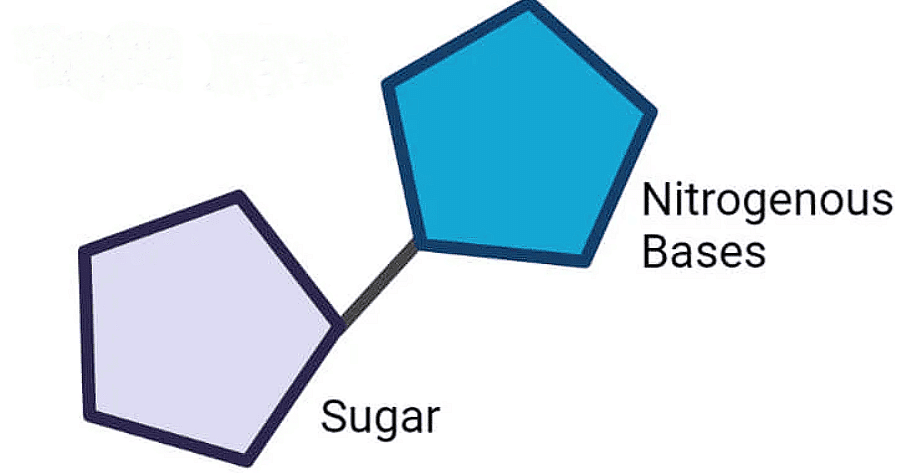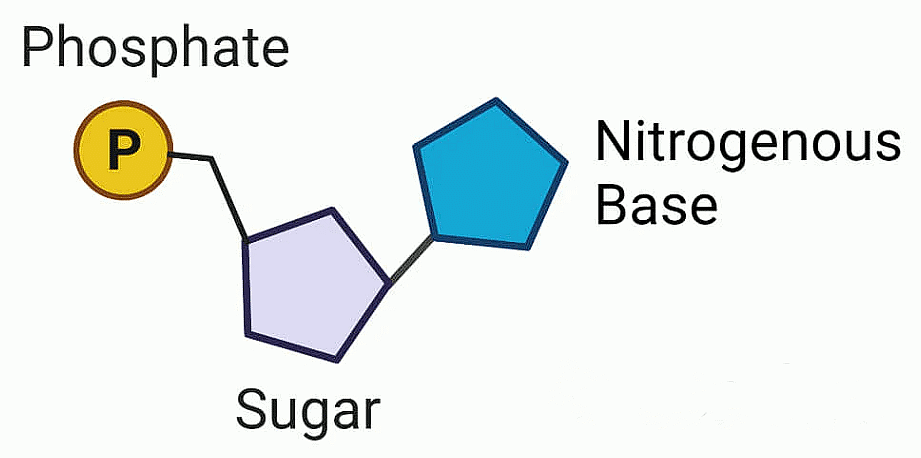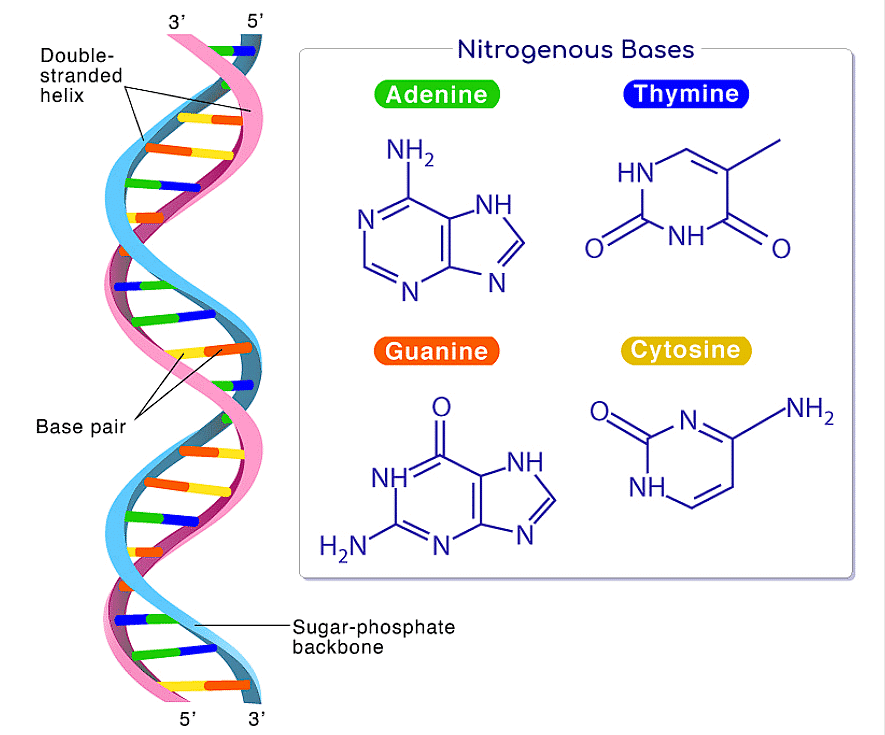The DNA & Packaging of DNA Helix | Biology Class 12 - NEET PDF Download
Nucleic acids are a fundamental class of biomolecules that play a central role in the storage, transmission, and expression of genetic information in living organisms. They are composed of long chains of smaller molecules called nucleotides, which serve as the building blocks of nucleic acids. with its unique functions and characteristics.
What are Nucleic Acids?
Nucleic acids are long-chain polymeric molecules, the monomer (the repeating unit) is known as the nucleotides and hence sometimes nucleic acids are referred to as polynucleotides.
Deoxyribonucleic acid (DNA) and ribonucleic acid (RNA) are two major types of nucleic acids. DNA and RNA are responsible for the inheritance and transmission of specific characteristics from one generation to the other.
What is Polynucleotide chain?
A polynucleotide chain is composed of monomers of nucleotide molecules. The structure of DNA is two nucleotide molecules wound together. Even RNA is made of a single chain of polynucleotides.
 Polynucleotide chain
Polynucleotide chain
Structure of Polynucleotide chain
A polynucleotide chain is a long chain of nucleotides, which are the building blocks of DNA and RNA molecules. The polynucleotide chain is held together by phosphodiester bonds between the sugar and phosphate groups, and the nitrogenous bases extend from the sugar-phosphate backbone, forming the rungs of the DNA or RNA ladder.
Each nucleotide is composed of three elements: Nucleotide Composition
Nucleotide Composition
- Nitrogenous base: There are two types of Nitrogenous bases
(i) Purines- Adenine (A) and Guanine (G) present in DNA as well as RNA
(ii) Pyrimidines- Cytosine (C) and Thymine (T) in DNA and Cytosine and Uracil in RNA. Thymine is also known as 5-methyl uracil and it is accounted for more stability of DNA molecule - Sugar: Pentose sugar- Ribose in RNA (ribonucleic acid), deoxyribose in DNA
- Phosphate group

Formation of Nucleosides
A nitrogenous base is linked to the 1' carbon of the pentose sugar through a N-glycosidic linkage to form a nucleoside.
 Structure of Nucleoside
Structure of Nucleoside
For example:
- Adenosine or deoxyadenosine
- Guanosine or deoxyguanosine
- Cytidine or deoxycytidine
- Uridine or deoxythymidine
Formation of Nucleotides
When a phosphate group is linked to the 5' carbon of a nucleoside through a phosphoester linkage, a nucleotide (or deoxynucleotide depending on the sugar type) is formed.
 Structure of Nucleotide
Structure of Nucleotide
- Dinucleotide and Polynucleotide Formation
- Two nucleotides are linked through a 3'-5' phosphodiester linkage to form a dinucleotide.
- More nucleotides can be joined in this manner to create a polynucleotide chain.
- The 5'-end of the polynucleotide chain has a free phosphate moiety, and the 3'-end has a free hydroxyl group of the 3' carbon on the sugar.
The backbone of a polynucleotide chain is formed by the sugar and phosphate groups. The nitrogenous bases are linked to the sugar moiety and project from the backbone.
Note: In RNA, each nucleotide residue has an additional -OH group at the 2' position in the ribose. RNA uses uracil in place of thymine (5-methyl uracil).
What is DNA?
DNA (deoxyribonucleic acid) is a long polymer made up of repeating units called nucleotides. These nucleotides consist of three key components: a deoxyribose sugar, a phosphate group, and a nitrogenous base. The structure of DNA can be described as a double helix, which was famously elucidated by James Watson and Francis Crick in 1953.
Discovery of DNA
DNA, initially identified by Friedrich Meischer in 1869 as 'Nuclein,' is an acidic substance found in the nucleus. The structure of DNA remained elusive due to technical limitations in isolating intact long polymers.
- In 1953, James Watson and Francis Crick proposed the famous Double Helix model for the structure of DNA, based on X-ray diffraction data from Maurice Wilkins and Rosalind Franklin. Their model included the concept of base pairing between the two strands of polynucleotide chains.
- Erwin Chargaff's observation that the ratios between Adenine and Thymine and Guanine and Cytosine are constant in double-stranded DNA was a key piece of evidence.
Structure and Composition of DNA
DNA exists as a double-stranded helix. The two strands of the helix run in opposite directions, with the sugar-phosphate backbones on the outside and the paired nitrogenous bases on the inside. The complementary base pairs hold the two strands together.
(a) Deoxyribose Sugar: Each nucleotide in a DNA strand contains a deoxyribose sugar molecule. Deoxyribose is a five-carbon sugar, and it forms the backbone of the DNA molecule.
(b) Phosphate Group: Attached to the deoxyribose sugar is a phosphate group. This phosphate group links adjacent nucleotides in the DNA strand, forming a sugar-phosphate backbone.
(c) Nitrogenous Bases: There are four different nitrogenous bases in DNA: adenine (A), thymine (T), cytosine (C), and guanine (G). These bases are the information-carrying part of DNA. The specific sequence of these bases encodes genetic information.
(d) Base Pairing: In DNA, the nitrogenous bases pair up in a complementary manner. Adenine (A) always pairs with thymine (T), and cytosine (C) always pairs with guanine (G). This complementary base pairing is crucial for the replication and stability of the DNA molecule.
 Composition of DNA
Composition of DNA
The length of DNA is typically measured in terms of the number of nucleotides or base pairs it contains. In your examples:
- The bacteriophage φX174 has 5386 nucleotides.
- Bacteriophage lambda has 48502 base pairs.
- Escherichia coli (E. coli) has 4.6 million (4.6 × 106) base pairs.
- The haploid content of human DNA is approximately 3.3 billion (3.3 × 109) base pairs.
Salient Features of DNA
(i) Double Polynucleotide Chains: DNA consists of two long chains made up of nucleotides. Each nucleotide comprises a sugar-phosphate backbone, and the nitrogenous bases (adenine, thymine, cytosine, and guanine) project inward towards the center of the helix.
 Structure of DNA
Structure of DNA
(ii) Anti-Parallel Polarity: The two polynucleotide chains in DNA run in opposite directions, with one chain having a 5' to 3' polarity and the other having a 3' to 5' polarity. This arrangement is often referred to as anti-parallel because the two chains have opposite orientations.
(iii) Base Pairing through Hydrogen Bonds: Adenine (A) always pairs with thymine (T), and guanine (G) always pairs with cytosine (C) through hydrogen bonds. Specifically, adenine forms two hydrogen bonds with thymine, and guanine forms three hydrogen bonds with cytosine. This base-pairing specificity ensures that a purine (A or G) is always paired with a pyrimidine (T or C), which maintains the uniform width of the DNA helix.
(iv) Right-Handed Helix: The two polynucleotide chains are twisted around each other in a right-handed fashion, resulting in a helical structure. This right-handed twist is an essential feature of the DNA double helix.
(v) Pitch and Base Pairs: The pitch of the DNA helix, or the distance between two complete turns of the helix, is approximately 3.4 nanometers (nm). Within this helical structure, there are roughly 10 base pairs per turn. The specific structure of the DNA double helix allows for efficient storage of genetic information and easy access for processes like DNA replication and transcription.
(vi) Stacking: The stability of the double-helix structure of DNA is further enhanced by the stacking of base pairs on top of each other. This stacking, in addition to the hydrogen bonds that connect the complementary bases, helps maintain the structural integrity of DNA. The bases in each base pair stack in a way that minimizes empty spaces between them, resulting in a tightly packed structure.
Packaging of DNA in Cells
DNA Packaging in Prokaryotes (e.g., E. coli)
In prokaryotic cells like E. coli, DNA is compacted and organized within a region called the nucleoid. The DNA is bound to proteins, forming large loops held by these proteins.
DNA Packaging in Eukaryotes
In eukaryotic cells, DNA packaging is more complex. It involves the use of positively charged proteins called histones, which form a histone octamer. The negatively charged DNA wraps around this histone octamer to form a nucleosome, consisting of approximately 200 base pairs of DNA. Nucleosomes are the basic repeating units of chromatin, visible as "beads-on-string" structures under an electron microscope.

Estimating the Number of Nucleosomes in a Mammalian Cell
Considering the typical length of DNA in a mammalian cell, we can imagine numerous nucleosomes. However, an exact count is challenging due to variations in cell types and conditions.
Chromatin Structure and Types
Nucleosomes form a "beads-on-string" structure in chromatin. These structures further coil and condense to form chromatin fibers, which ultimately condense into chromosomes during cell division.
Chromatin can be loosely packed (euchromatin) or densely packed (heterochromatin). Euchromatin is transcriptionally active, while heterochromatin is inactive. These distinctions are important for gene regulation and cellular processes.
|
78 videos|277 docs|174 tests
|
FAQs on The DNA & Packaging of DNA Helix - Biology Class 12 - NEET
| 1. What are nucleic acids and what is their function in living organisms? |  |
| 2. What is a polynucleotide chain and how is it formed? |  |
| 3. What is the structure of DNA and how does it differ from RNA? |  |
| 4. What are the salient features of DNA that contribute to its role in heredity? |  |
| 5. How is DNA packaged in cells, and why is this process important? |  |























